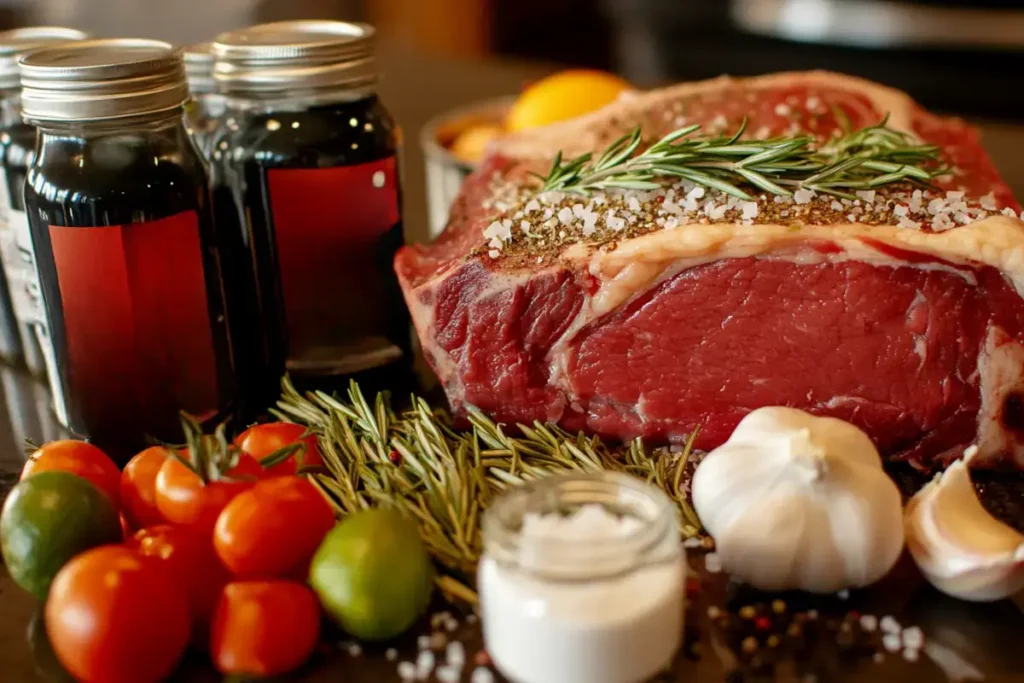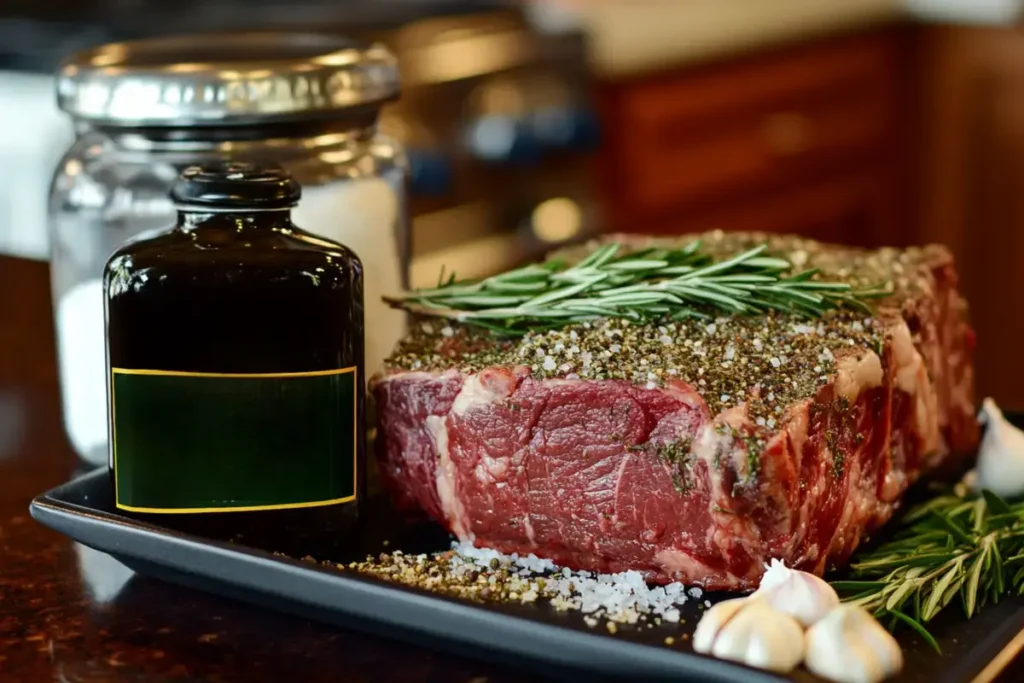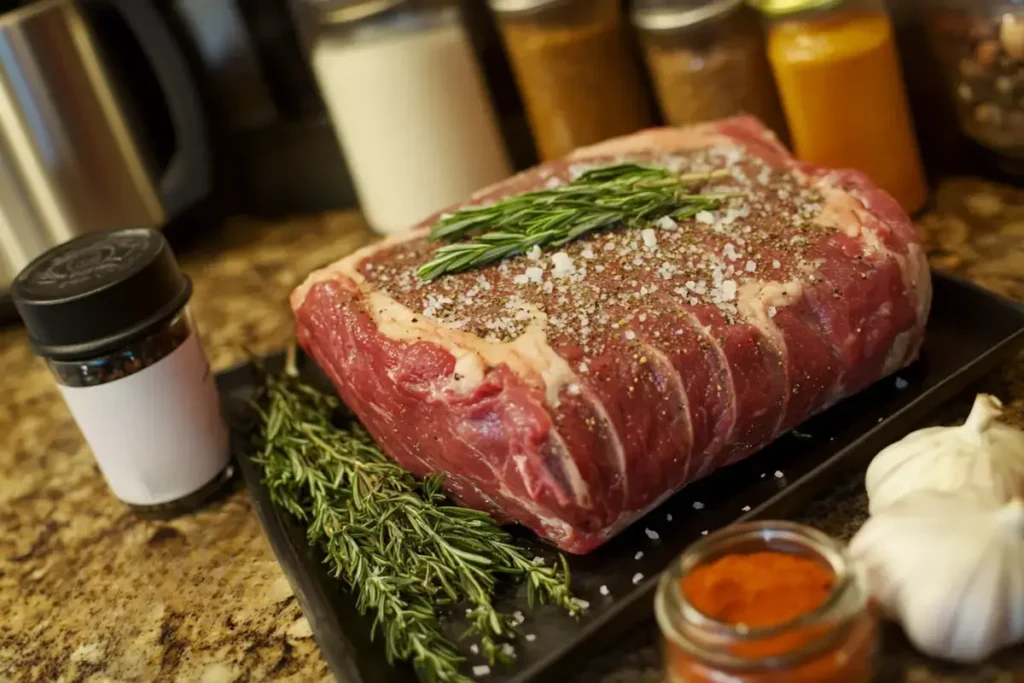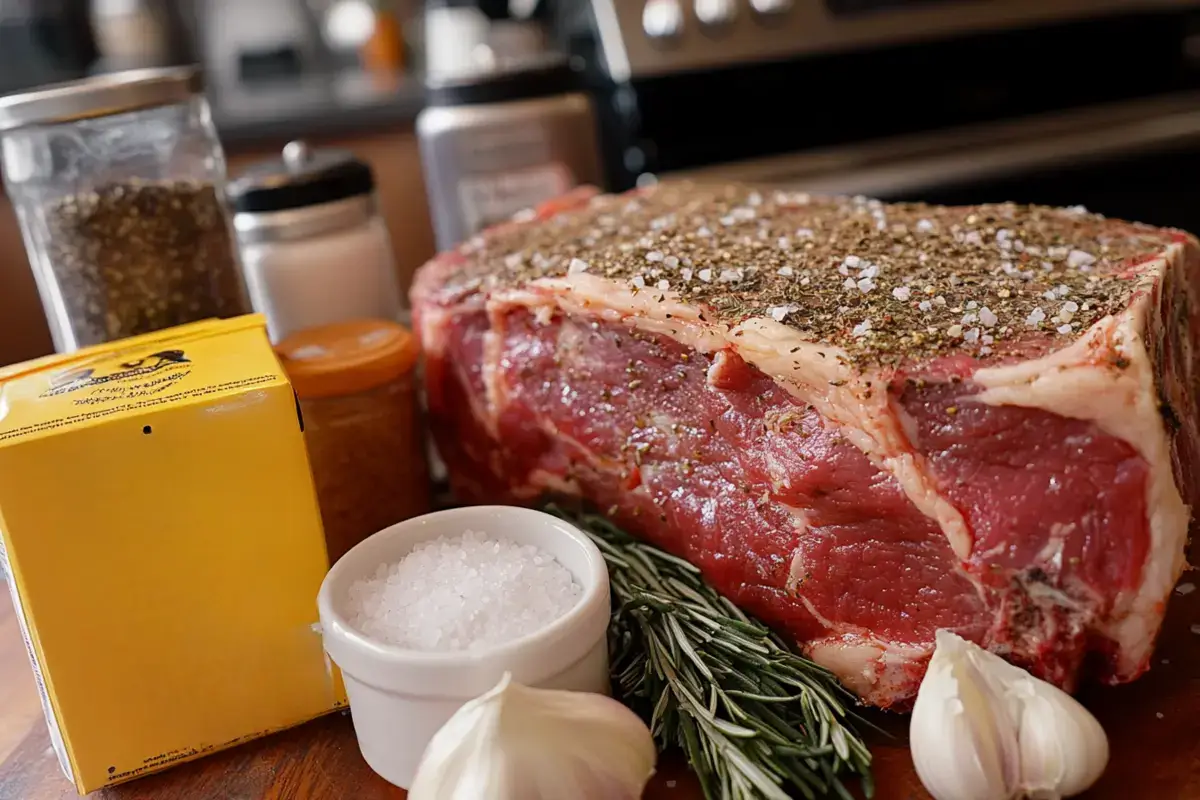Master the art of prime rib seasoning with expert tips, flavorful herbs, and proper techniques.
Proper seasoning can transform prime rib into a remarkable meal. Below, you will discover how to select, prepare, and season your roast for maximum flavor.
Understanding the Anatomy of Prime Rib
Prime rib is beloved for its juicy interior and rich marbling. This cut, also called a standing rib roast, comes from the primal rib section of beef. Because it retains excellent marbling, it remains tender and offers robust beefy flavor. Indeed, every bite feels luxurious.
However, quality varies across different grades of beef. Comparatively, Prime grade features the highest level of marbling. Chiefly, this makes it more flavorful and tender. Initially, you should look for a roast with bright red color and white flecks of fat throughout. Selecting such a cut ensures a succulent texture after cooking.
Equally, the bone-in prime rib offers extra flavor. The bones help distribute heat more evenly and protect the meat. Eventually, you can remove the bones or leave them attached. Another factor is the roast’s size. Typically, one bone can serve two people. Nonetheless, consider ordering a slightly bigger roast if you want generous servings or leftovers.
Essential Tools and Ingredients
Tools You Will Need:
- Meat Thermometer: Ensures accurate internal temperature readings.
- Roasting Pan: Holds the roast and catches drippings for gravy.
- Sharp Knife: Helps with trimming excess fat and carving.
- Butcher’s Twine: Keeps the roast securely tied for even cooking.
Ingredients That Elevate Flavor:
- Salt: Draws out moisture, creating a savory crust.
- Ground Black Pepper: Adds spice and earthy depth.
- Garlic: Brings pungent aroma and sweetness once roasted.
- Onion Powder: Adds mild, sweet complexity.
- Fresh Herbs: Rosemary, thyme, and oregano for classic, aromatic flavors.
- Optional Spices: Paprika, cumin, chili powder, or smoked salt for a twist.
Moreover, selecting fresh and high-quality herbs ensures the best infusion of flavor. Undoubtedly, salt is the most essential. Particularly, kosher salt or sea salt crystals cling to the roast better. They penetrate deeply when given enough time to rest.
What Is the Best Way to Season a Prime Rib? Key Preparations
What is the best way to season a prime rib? It begins with proper preparation. Comparatively, a meticulously prepared roast locks in moisture and sets the foundation for a delectable meal. Chiefly, you have two main options:
- Dry-Brining: Coat the meat in salt, then rest uncovered in the refrigerator. Subsequently, the salt draws out moisture, dissolves, and reabsorbs into the roast. This method enhances tenderness and flavor from the inside out.
- Wet-Brining: Submerge the prime rib in a saltwater solution with herbs and spices. Eventually, the roast absorbs salty liquid, offering a juicy bite.
- Basic Spice Rub: Combine salt, pepper, onion powder, and garlic powder. Pat the roast dry, then cover every surface with the rub. Afterward, let the seasoned roast rest in the refrigerator for at least a few hours.
Altogether, these preparations set you up for success. Likewise, the resting period allows flavors to permeate. This step ensures the seasoning reaches the center of the roast. Hence, do not skip the prep work.

What Is the Best Way to Season a Prime Rib? Flavorful Herbs and Spices
What is the best way to season a prime rib? It often involves a tapestry of herbs and spices. Especially, classic herbs like rosemary, thyme, and oregano complement prime rib’s rich profile. Additionally, their aromatic oils seep into the meat during cooking.
Classic Herb Blend:
- Minced fresh rosemary
- Minced thyme
- Oregano leaves
- Cracked black pepper
- Kosher salt
Mix the herbs, salt, and pepper, then massage onto the roast. Basically, this combination yields an herby crust that pairs well with beef’s natural savoriness.
Bolder Spice Options:
- Paprika or smoked paprika
- Chili powder
- Cayenne pepper (for heat)
- Cumin for an earthy touch
- Coriander for citrusy undertones
Blending these spices with salt and a bit of sugar forms a robust bark on the roast’s exterior. Conversely, you could combine them with oil or melted butter to create a paste. This paste adheres to the prime rib, imparting an extra dimension of flavor.
Combining Herbs and Spices:
For an elevated twist, merge classic herbs with bolder spices. Comparatively, balancing intense chili flavors with earthy rosemary results in a taste that is both traditional and adventurous. Particularly, remember that moderation is key. Aim for a cohesive taste, not a clash of overbearing flavors.
What Is the Best Way to Season a Prime Rib? Common Mistakes to Avoid
Even the best cooks make errors. What is the best way to season a prime rib? It involves sidestepping these pitfalls to preserve flavor.
- Over-Seasoning:
Nevertheless, too much salt can overshadow beef’s natural taste. Particularly if you plan to let the roast rest, salt continues to penetrate deeper. Measure your seasoning carefully. - Under-Seasoning:
Generally, prime rib has a thick layer of meat. Under-seasoning leaves the interior bland. Equally, ensure you coat every inch thoroughly. Include the sides and any crevices. - Forgetting to Tie or Rest Properly:
Comparatively, an untied prime rib can lose shape. Tying helps with even heat distribution. Subsequently, resting the roast after seasoning ensures flavors seep in. Afterward, resting post-cooking locks in the juices for a succulent bite.
What Is the Best Way to Season a Prime Rib? Step-by-Step Seasoning Method
What is the best way to season a prime rib? A systematic approach yields consistent results. Follow this simple process:
- Select and Trim:
Choose a fresh, well-marbled prime rib. Trim excess surface fat, leaving a thin layer for flavor. Because some roasts come pre-trimmed, you may not need major adjustments. - Create the Marinade or Rub:
Combine your chosen seasonings—salt, pepper, garlic, herbs, or spices. Explicitly, measure out each component to maintain balance. Add a drizzle of olive oil if desired, and mix until you form a paste. - Properly Apply and Massage:
Pat the roast dry. Use your hands to spread the mixture evenly, pressing it into every inch of the surface. Comparatively, ensure the seasoning touches any folds or crevices. Wrap the roast in plastic or foil, then refrigerate.
What Is the Best Way to Season a Prime Rib? Ideal Marinade Period
Timing influences the depth of flavor. What is the best way to season a prime rib? Let’s explore:
- 24-Hour Marinade:
Undoubtedly, this is a popular option for maximum flavor infusion. Season the roast one day in advance and store it in the refrigerator. The salt and spices penetrate deeply, tenderizing and taste-busting. - Overnight Marinade:
If you have less time, 8–12 hours can suffice. Chiefly, you still gain plenty of flavor. Turn the roast halfway if using a liquid marinade to distribute flavors evenly. - Quick Marinade:
In a pinch, you can season and let it sit for 1–2 hours. Comparatively, this produces less penetration, but the outside will still pick up a robust crust during cooking. Nonetheless, the roast remains appetizing.

What Is the Best Way to Season a Prime Rib? Expert Tips and Tricks
Professional chefs have a few secrets up their sleeves. What is the best way to season a prime rib? Consider these pointers:
- Controlling Cooking Temperature:
Specifically, slow and low cooking helps break down connective tissues. This ensures a tender roast. Likewise, searing at a high temperature first locks in juices. - Smoking Technique:
Meanwhile, using a smoker adds a woody, aromatic flavor. Hickory, oak, or fruitwood chips infuse the meat with a subtle smokiness. Particularly, maintain a steady heat and keep the lid closed to prevent moisture loss. - Searing for a Crisp Crust:
Furthermore, preheat a cast-iron skillet or your roasting pan at high temperature. Sear each side for a minute or two. Hence, you develop a gorgeous exterior before roasting. This step adds a delightful texture contrast.
Cooking Methods
Because prime rib is versatile, you can cook it in several ways. Each method offers distinct benefits.
- Oven Roasting:
- Initial High Heat: Blast the roast at 450°F for 15 minutes.
- Lower Temperature: Reduce to 325°F until the roast reaches your desired doneness.
- Advantages: This method is straightforward and yields a crispy exterior.
- Smoking:
- Preheat Smoker: Maintain a temperature around 225°F.
- Use Wood Chips: Hickory or applewood for depth of flavor.
- Advantages: Slow cooking ensures juicy tenderness and a mouthwatering smoky aroma.
- Grilling:
- Two-Zone Setup: One side high heat, the other low or no heat.
- Sear and Then Indirect Heat: Sear the roast quickly on the high-heat side, then move it to the cooler side.
- Advantages: Imparts a grilled crust and slightly charred flavor.
- Sous Vide:
- Precision Cooking: Vacuum-seal and immerse in water at your target temperature.
- Final Sear: After sous vide, sear the roast on a hot grill or pan to form a crust.
- Advantages: Guarantees an even doneness from edge to edge.
Eventually, choose the method that best suits your equipment, time, and taste preferences. Altogether, these various techniques can amplify your prime rib experience.
Temperature Control and Resting
Heat control is crucial. Aim for medium-rare to medium levels of doneness because prime rib tastes best when pink in the center. Generally, use these temperature guidelines:
- Rare: 120–125°F
- Medium-Rare: 130–135°F
- Medium: 140–145°F
Nevertheless, insert a reliable thermometer into the thickest part of the roast for accurate readings. When the roast nears your preferred temperature, remove it from the heat source. Afterward, let it rest for 15–30 minutes. Hence, the juices redistribute, resulting in a succulent bite. Cutting too soon causes the juices to run out, leaving the meat drier than intended.
Carving and Serving Suggestions
Carving prime rib properly maximizes tenderness. Carefully slice between the bones if it’s bone-in. Then, cut across the grain into thick pieces. This method preserves the roast’s natural juiciness. Subsequently, serve with classic accompaniments or more creative sides:
- Creamy Horseradish Sauce: Tangy heat complements rich beef.
- Au Jus: Made from pan drippings, adds savory moisture.
- Mashed Potatoes or Roasted Vegetables: Soak up the prime rib’s juices.
- Yorkshire Pudding: A traditional English pairing.
Indeed, a perfectly carved prime rib boasts a uniform blush and a crust that crackles under your knife.

Conclusion
At this point, you may wonder, what is the best way to season a prime rib? The answer hinges on thoughtful preparation, the right blend of herbs and spices, and an awareness of common pitfalls. Basically, you should select a quality cut, marinate or rub it overnight, and choose a suitable cooking technique. Finally, manage temperature carefully and let the roast rest before carving.
Seasoning prime rib is an art. Therefore, do not be afraid to mix up your flavors and experiment with different herbs and spices. The goal is to enhance rather than overpower. Whether you stick with a classic herb rub or venture into bolder territory, you hold the key to prime rib perfection.
Frequently Asked Questions (FAQs)
1. What is the secret to a good prime rib?
The secret lies in selecting a well-marbled cut, seasoning it generously with salt, and allowing time for the flavors to penetrate. Additionally, controlling the cooking temperature and letting the roast rest ensures a moist, tender result.
2. How do you get the best flavor on prime rib?
Use a well-rounded seasoning blend that includes salt, fresh herbs, and spices. Comparatively, letting the roast marinate or rest overnight maximizes flavor absorption. A quick sear or high-heat blast at the beginning of cooking also helps develop a savory crust.
3. What should I put on my prime rib before cooking?
Many cooks start with a simple rub of salt, pepper, garlic powder, and onion powder. Furthermore, you can add fresh herbs like rosemary or thyme for an aromatic crust. Explicitly, consider adding a bit of olive oil or melted butter to help the seasoning stick.
4. How do restaurants make prime rib so tender?
Restaurants often buy high-grade beef with excellent marbling. Additionally, they marinate or dry-brine the roast for extended periods, maintaining low heat for slow, gentle cooking. Finally, they rest the meat to lock in the juices before carving and serving.

